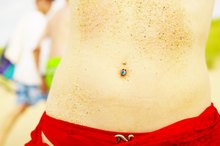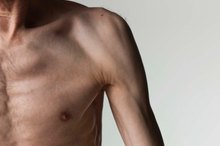What does fact checked mean?
At Healthfully, we strive to deliver objective content that is accurate and up-to-date. Our team periodically reviews articles in order to ensure content quality. The sources cited below consist of evidence from peer-reviewed journals, prominent medical organizations, academic associations, and government data.
The information contained on this site is for informational purposes only, and should not be used as a substitute for the advice of a professional health care provider. Please check with the appropriate physician regarding health questions and concerns. Although we strive to deliver accurate and up-to-date information, no guarantee to that effect is made.
Does it Hurt to Have Your Palm Tattooed?
Tattoos are generally more painful in less padded areas of the body, and where the skin is most sensitive. The palm of your hand has almost no fat padding, and is one of the more sensitive areas of the body. This combination adds up to a palm tattoo being acknowledged as one of the most painful tattoos you can get.
Expert Insight
According to the science website ThinkQuest, some parts of the body are relatively more sensitive to touch—and pain—than others. This is because the receptors in your skin are not distributed uniformly throughout your body. The palm of your hand is typically slightly less sensitive than your fingers, upper lip, nose or cheek, but more sensitive than most of your other body parts. The palm is roughly four times more sensitive than the shoulder or calf.
- According to the science website ThinkQuest, some parts of the body are relatively more sensitive to touch—and pain—than others.
- The palm of your hand is typically slightly less sensitive than your fingers, upper lip, nose or cheek, but more sensitive than most of your other body parts.
Causes
The Risks of Wrist Tattoos
Learn More
Tattoos on the palm are also painful because there is very little fat on palms, which are very sensitive parts of the body. In general, the more padded an area of your body, the less painful it will be to get tattooed. Therefore, tattoos on the thigh, calf, stomach or upper arm are generally less painful than those tattoos where there is little padding between the skin and your bones. Tattoos on knuckles or directly over the spine will typically be more painful because of the lack of padding.
- Tattoos on the palm are also painful because there is very little fat on palms, which are very sensitive parts of the body.
- Therefore, tattoos on the thigh, calf, stomach or upper arm are generally less painful than those tattoos where there is little padding between the skin and your bones.
Risks
Because the skin on your palm has a different and faster regrowth pattern than the rest of your body, palm tattoos are susceptible to faster fading than other tattoos. They may need retouching every few months or years. Any tattoo carries certain risks associated with the tattoo needle breaching the skin, according to MayoClinic.com. These risks include allergic reactions to the tattoo ink, skin infections, skin bumps known as granulomas, the development of keloid scars at the tattoo site or blood-borne diseases from contaminated tattooing equipment.
- Because the skin on your palm has a different and faster regrowth pattern than the rest of your body, palm tattoos are susceptible to faster fading than other tattoos.
- Any tattoo carries certain risks associated with the tattoo needle breaching the skin, according to MayoClinic.com.
Prevention/Solution
How to Remove Bandage Adhesive From Skin
Learn More
Palm tattoos may fade, dissipate or "fall out" of the hand 2. Because of the way the skin of your palm regenerates, the lines of a tattoo on the palm may also thicken over a period of months. Palm tattoos are also relatively susceptible to sun damage, so it is important to keep your palm tattoo protected with sunscreen any time you are out in the sun 2. Having the tattoo placed relatively deep in the skin can reduce fading.
Warning
Many tattoo artists advise against getting the palms of your hands tattooed. In addition to being painful, palm tattoos are extremely visible and may be a barrier to employment. Unlike tattoos on other parts of your body, palm tattoos cannot be covered by clothing unless you wear gloves the whole time you are at work. Additionally, MayoClinic.com cautions that tattoo ink—classified as a cosmetic product—is not subject to approval or regulation by the United States Food and Drug Administration.
- Many tattoo artists advise against getting the palms of your hands tattooed.
- Unlike tattoos on other parts of your body, palm tattoos cannot be covered by clothing unless you wear gloves the whole time you are at work.
Related Articles
References
- MayoClinic.com: Tattoos—Understand Risks and Precautions
- Check Out My Ink: Gotta Love the Palm Tattoos
- Lynn C, Michaela, Herdrich D, et al. The evolutionary adaptation of body art: Tattoo as an honest signal of enhanced immune response in American Samoa. Amer J Hum Biol. 2019:e23347. doi:10.1002/ajhb.23347
- Wilson WT, O’Boyle M, Leach WJ. Unusual complication of a tattoo in an immunosuppressed patient. Case Reports 2018; 2018:bcr-2018-224968. doi:10.1136/bcr-2018-224968
- Oanţă A, Irimie M. Tinea on a tattoo. Acta Dermatovenerol Croat. 2016;24(3):223-4.
- Tohme RA, Holmberg SD. Transmission of hepatitis C virus infection through tattooing and piercing: a critical review. Clin Infect Dis. 2012;54:1167–1178. doi:10.1093/cid/cir991
- Centers for Disease Control and Prevention. HIV transmission. Updated August 6, 2019.
- Warshaw EM, Schlarbaum JP, Taylor JS, et al. Allergic reactions to tattoos: Retrospective analysis of North American Contact Dermatitis Group data, 2001-2016. J Am Acad Dermatol. 2019;2:e61-e62. doi:10.1016/j.jaad.2019.09.077
- Kirby W, Alston DB, Chen AH. The incidence of hypertrophic scarring and keloid formation following laser tattoo removal with a quality-switched Nd:YAG laser. J Clin Aesthet Dermatol. 2016;9(5):43–47.
- Islam PS, Chang C, Selmi C, et al. Medical complications of tattoos: A comprehensive review. Clin Rev Allergy Immunol. 2016;50(2):273-86. doi:10.1007/s12016-016-8532-0
- Valbuena MC, Franco VE, Sánchez L, Jiménez HD. Sarcoidal granulomatous reaction due to tattoos: report of two cases. An Bras Dermatol. 2017;92(5 Suppl 1):138–141. doi:10.1590/abd1806-4841.20175860
- Orzan OA, Popa LG, Vexler ES, Olaru I, Voiculescu VM, Bumbăcea RS. Tattoo-induced psoriasis. J Med Life. 2014;7 Spec No. 2(Spec Iss 2):65–68.
- Ross JR, Matava MJ. Tattoo-induced skin "burn" during magnetic resonance imaging in a professional football player: a case report. Sports Health. 2011;3(5):431–434. doi:10.1177/1941738111411698
- Kaur RR, Kirby W, Maibach H. Cutaneous allergic reactions to tattoo ink. J Cosmet Dermatol. 2009;8:295-300. doi:10.1111/j.1473-2165.2009.00469.x
- Brady BG, Gold H, Leger EA, Leger MC. Self-reported adverse tattoo reactions: a New York City Central Park study. Contact Dermatitis. 2015 Aug;73:91-99. doi:10.1111/cod.12425
- Forbat E, Al-Niaimi F. Patterns of reactions to red pigment tattoo and treatment methods. Dermatol Ther (Heidelb). 2016;6(1):13–23. doi:10.1007/s13555-016-0104-y
- Rosenbaum BE, Milam EC, Seo L, Leger MC. Skin care in the tattoo parlor: A survey of tattoo artists in New York City. Dermatology. 2016;232:484-489. doi:10.1159/000446345
- Khunger N, Molpariya A, Khunger A. Complications of tattoos and tattoo removal: Stop and think before you ink. J Cutan Aesthet Surg. 2015;8:30–36. doi:10.4103/0974-2077.155072
- United States Food and Drug Administration. Tattoos & permanent makeup; fact sheet. Oct 31, 2019.
Writer Bio
Jae Allen has been a writer since 1999, with articles published in "The Hub," "Innocent Words" and "Rhythm." She has worked as a medical writer, paralegal, veterinary assistant, stage manager, session musician, ghostwriter and university professor. Allen specializes in travel, health/fitness, animals and other topics.









